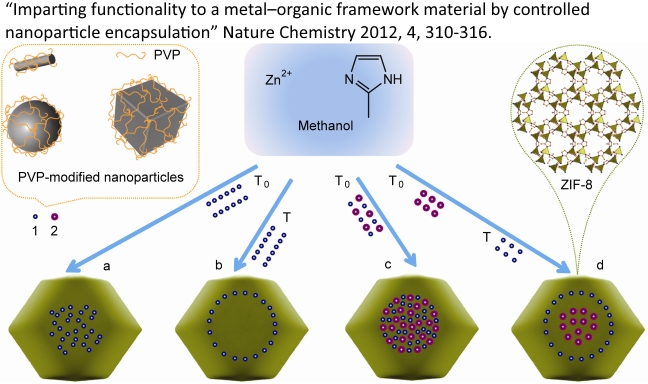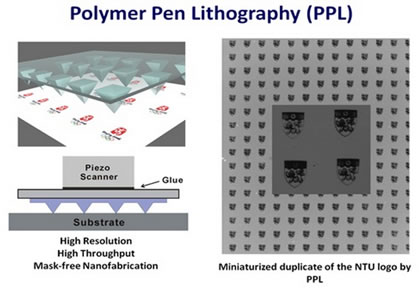The current research of Prof. Huo’s group involves nanolithography, functional nanomaterials, porous materials, metal-organic frameworks (MOFs) materials, nanodevice, and so on. One goal of my team is to explore the application of high throughput nanolithography approaches (polymer pen lithography, beam pen lithography, etc), such as fabrication of nano devices, biochips, optical materials, metamaterials, etc. The other field of my team is to design and develop functional MOFs composite materials for energy storage, chemical catalysis, sensor, energy transform, drug delivery, nano-device, etc.
 |
||||
Functional Metal-Organic Framework MaterialsMetal-organic frameworks (MOFs) have shown great promise for a variety of applications, including gas storage, chemical separation, catalysis and sensing. Particularly, the incorporation of nanoparticles in MOFs has attracted great attention because of the benefits of the novel chemical and physical properties exhibited by certain classes of nanoparticles. Recently, we have developed an encapsulation strategy that allows several types of nanoparticles to be fully incorporated within crystals of a readily synthesized zeolitic imidazolate framework material ZIF-8, in a well-dispersed fashion. This allows ready control over the spatial distribution of nanoparticles within ZIF-8 crystals by adjusting the time of nanoparticle addition during the MOF-formation reaction. The as-prepared hybrid materials exhibit both active (catalytic, magnetic, and optical) properties deriving from the incorporated nanoparticles and size- and alignment-selective behavior (i.e., molecular sieving and regioselective guest reactivity) originating from the well-defined microporous nature of the MOF components. Representative publications: Nature Chemistry, 2012, 4, 310-316; Advanced Materials, 2012, 24, 5954-5958. |
||||
| Parallel Nanolithography Polymer Pen Lithography (PPL) is a new patterning method developed recently that combines the advantages of soft-lithography and DPN to achieve high-throughput, low-cost, flexible molecular printing that may revolutionize the field of nanopatterning. PPL is a cantilever-free, parallel lithographic approach that uses elastomeric tips to print a digitized pattern with spot sizes ranging from 90 nm to over 10 mm. When sharp tips are brought into contact with the substrate, ink is delivered at the points of contact. PPL is a direct-write technique, it is ideal for producing complex patterns relevant to rapid prototyping and studies of electronic, optical and metal material structures and devices. It can fabricate arrays of structures made of soft matter, such as proteins, making it potentially useful in the life sciences as well. Representative publications: Nature Nanotechnology, 2010, 5, 637-640; Science, 2008, 321, 1658-1660. | ||||
 |
SELECTED PUBLICATIONS
(1) Li, S. Z.; Shi, W. X.; Lu, G.; Li, S. Z.; Loo, S. C. J.; Huo, F.* “Unconventional Nucleation and Oriented Growth of ZIF-8 Crystals on Non-Polar Surface”, Advanced Materials,2012,24, 5954-5958.
(2) Lu, G.; Li, S.; Guo, Z.; Farha, O. K.; Hauser, B. G.; Qi, X.; Wang, Y.; Wang, X.; Han, S.; Liu, X.; DuChene, J. S.; Zhang, H.; Zhang, Q.; Chen, X.; Ma, J.; Joachim Loo, S. C.; Wei, D. W.; Yang, Y.; Hupp, J. T.*; Huo, F.* “Imparting functionality to a metal–organic framework material by controlled nanoparticle encapsulation” Nature Chemistry2012, 4, 310-316.
(3) Huo, F.; Zheng, G.; Liao, X.; Giam, L. R.; Chai, J.; Chen, X.; Shim, W.Y.; Mirkin, C. A. “Beam pen lithography” Nature Nanotechnology, 2010, 5, 637-640.
(4) Huo, F., Zheng, Z., Zheng, G.; Giam, L. R.; Zhang H.; Mirkin, C. A. “Polymer Pen Lithography” Science, 2008, 321, 1658-1660.